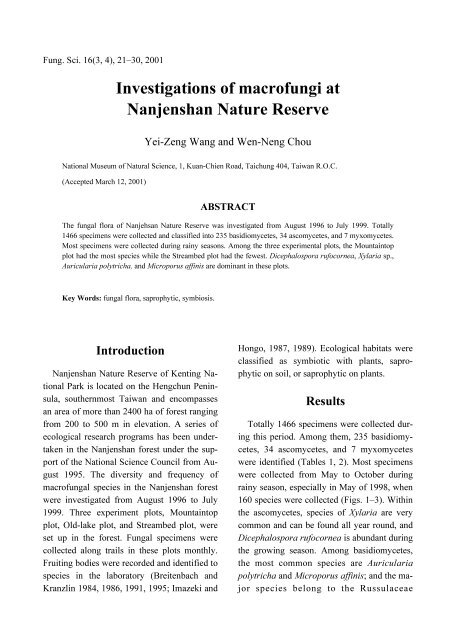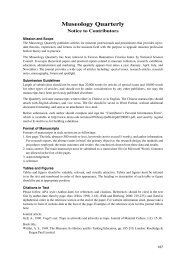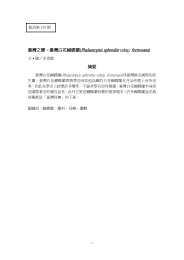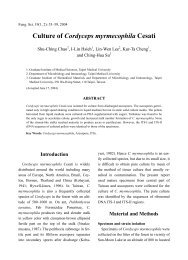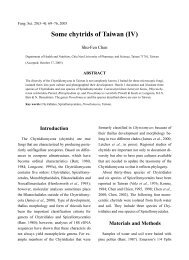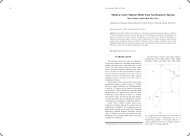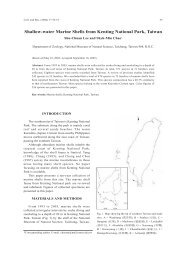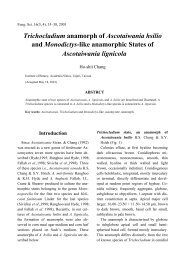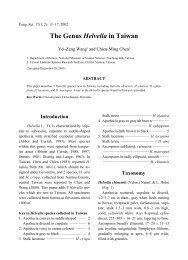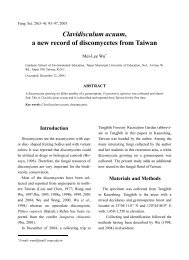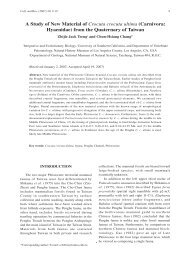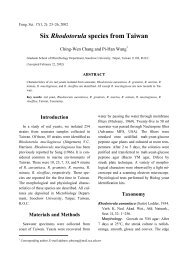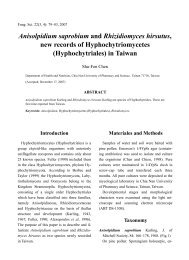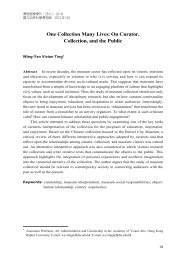Investigations of macrofungi at Nanjenshan Nature Reserve
Investigations of macrofungi at Nanjenshan Nature Reserve
Investigations of macrofungi at Nanjenshan Nature Reserve
Create successful ePaper yourself
Turn your PDF publications into a flip-book with our unique Google optimized e-Paper software.
Fung. Sci. 16(3, 4), 21–30, 2001<br />
<strong>Investig<strong>at</strong>ions</strong> <strong>of</strong> macr<strong>of</strong>ungi <strong>at</strong><br />
<strong>Nanjenshan</strong> N<strong>at</strong>ure <strong>Reserve</strong><br />
Yei-Zeng Wang and Wen-Neng Chou<br />
N<strong>at</strong>ional Museum <strong>of</strong> N<strong>at</strong>ural Science, 1, Kuan-Chien Road, Taichung 404, Taiwan R.O.C.<br />
(Accepted March 12, 2001)<br />
ABSTRACT<br />
The fungal flora <strong>of</strong> Nanjehsan N<strong>at</strong>ure <strong>Reserve</strong> was investig<strong>at</strong>ed from August 1996 to July 1999. Totally<br />
1466 specimens were collected and classified into 235 basidiomycetes, 34 ascomycetes, and 7 myxomycetes.<br />
Most specimens were collected during rainy seasons. Among the three experimental plots, the Mountaintop<br />
plot had the most species while the Streambed plot had the fewest. Dicephalospora rufocornea, Xylaria sp.,<br />
Auricularia polytricha, and Microporus affinis are dominant in these plots.<br />
Key Words: fungal flora, saprophytic, symbiosis.<br />
Introduction<br />
<strong>Nanjenshan</strong> N<strong>at</strong>ure <strong>Reserve</strong> <strong>of</strong> Kenting N<strong>at</strong>ional<br />
Park is loc<strong>at</strong>ed on the Hengchun Peninsula,<br />
southernmost Taiwan and encompasses<br />
an area <strong>of</strong> more than 2400 ha <strong>of</strong> forest ranging<br />
from 200 to 500 m in elev<strong>at</strong>ion. A series <strong>of</strong><br />
ecological research programs has been undertaken<br />
in the <strong>Nanjenshan</strong> forest under the support<br />
<strong>of</strong> the N<strong>at</strong>ional Science Council from August<br />
1995. The diversity and frequency <strong>of</strong><br />
macr<strong>of</strong>ungal species in the <strong>Nanjenshan</strong> forest<br />
were investig<strong>at</strong>ed from August 1996 to July<br />
1999. Three experiment plots, Mountaintop<br />
plot, Old-lake plot, and Streambed plot, were<br />
set up in the forest. Fungal specimens were<br />
collected along trails in these plots monthly.<br />
Fruiting bodies were recorded and identified to<br />
species in the labor<strong>at</strong>ory (Breitenbach and<br />
Kranzlin 1984, 1986, 1991, 1995; Imazeki and<br />
Hongo, 1987, 1989). Ecological habit<strong>at</strong>s were<br />
classified as symbiotic with plants, saprophytic<br />
on soil, or saprophytic on plants.<br />
Results<br />
Totally 1466 specimens were collected during<br />
this period. Among them, 235 basidiomycetes,<br />
34 ascomycetes, and 7 myxomycetes<br />
were identified (Tables 1, 2). Most specimens<br />
were collected from May to October during<br />
rainy season, especially in May <strong>of</strong> 1998, when<br />
160 species were collected (Figs. 1–3). Within<br />
the ascomycetes, species <strong>of</strong> Xylaria are very<br />
common and can be found all year round, and<br />
Dicephalospora rufocornea is abundant during<br />
the growing season. Among basidiomycetes,<br />
the most common species are Auricularia<br />
polytricha and Microporus affinis; and the major<br />
species belong to the Russulaceae
22 Fung. Sci. 16(3, 4), 2001<br />
Table 1. Loc<strong>at</strong>ions and numbers <strong>of</strong> Ascomycetes and Myxomycetes collected in <strong>Nanjenshan</strong> from Aug. 1996 to July<br />
1999.<br />
Fungal species<br />
Ascomycetes<br />
Loc<strong>at</strong>ion* Ecological habit<strong>at</strong>s# Numbers<br />
Bulgariella pulla 1 L 1<br />
Cer<strong>at</strong>osphaeria sp. 3 L 1<br />
Ciboria sp. 3 L 1<br />
Cookeina insititia 3 L 2<br />
Coprobia sp. 1 T 1<br />
Daldinia concentrica 2 L 1<br />
Dicephalospora rufocornea 1, 2, 3 L 15<br />
Galiella javanica 1 L 1<br />
Hypocrea rufa 1,2 L 5<br />
Hypocrea sp. 1, 2, 3 L 3<br />
Hypoxylon trunc<strong>at</strong>um 1, 3 L 2<br />
Hypoxylon sp. 1 L 2<br />
Kretzschmaria scruposa 1, 3 L 4<br />
Lachnum scleroti 1 L 1<br />
Moellerodiscus lentus 1, 3 L 2<br />
Mollisia sp. 2 L 1<br />
Nectria sp. 3 L 1<br />
Orbilia sarraziniana 3 L 1<br />
Perrotia nanjenshana 1,2,3 L 4<br />
Peziza cerea 1 L 1<br />
Peziza moravecii 1 L 1<br />
Phillipsia domingensis 3 L 1<br />
Rhopalostrama luzonensis 1 L 6<br />
Sclerotinia sp. 3 L 1<br />
Scutellinia jungeri 3 L 1<br />
Scutellinia subhirtella 1 T 1<br />
Xylaria allantoidea 1, 2, 3 L 4<br />
Xylaria anisopleura 3 L 2<br />
Xylaria cubensis 2, 3 L 6<br />
Xylaria formosana 1 L 1<br />
Xylaria hippotrichoides 3 L 1<br />
Xylaria kretzchmaria 3 L 1<br />
Xylaria schweinitzii 1 L 1<br />
Xylaria sp.<br />
Myxomycetes<br />
1, 2, 3 L 11<br />
Arcyria cinerea 1 L 1<br />
Arcyria denud<strong>at</strong>a 1 L 1<br />
Cer<strong>at</strong>iomyxa fruticulosa 1 L 1<br />
Lycogala epidendrum 1 L 1<br />
Lycogala exiguum 1 L 2<br />
Physarum stell<strong>at</strong>um 2 L 1<br />
Stemonitis splendens 1 L 2<br />
*1: Mountaintop plot; 2: Old-lake plot; 3: Streambed plot. #S: Symbiotic with plants; T: Saprophytic on soil; L: Saprophytic<br />
on plants.
<strong>Investig<strong>at</strong>ions</strong> <strong>of</strong> macr<strong>of</strong>ungi 23<br />
Table 2. Loc<strong>at</strong>ions and numbers <strong>of</strong> Basidiomycetes collected in <strong>Nanjenshan</strong> from Aug. 1996 to July 1999.<br />
Fungal species Loc<strong>at</strong>ion* Ecological habit<strong>at</strong>s# Numbers<br />
Agaricus praeclaresquamosus 1 T 1<br />
Agaricus purpurellus 1, 2 T 5<br />
Agaricus sp. 1, 2, 3 T 6<br />
Amanita gymnopus 2 S 1<br />
Amanita hemibapha 1 S 2<br />
Amanita sychnopyramis 2 S 4<br />
Amanita vagin<strong>at</strong>a 1, 2 S 8<br />
Amanita sp. 1, 2 S 18<br />
Amauroderma rugosum 1, 2 L 6<br />
Auricularia auricula 1 L 1<br />
Auricularia polytricha 1, 2, 3 L 40<br />
Austroboletus fusisporus 1 S 1<br />
Austroboletus sp. 1, 2 S 3<br />
Boletellus ananas 1, 2 S 7<br />
Boletellus emodensis 1 S 2<br />
Boletellus obscurecoccineus 2 S 1<br />
Boletellus sp. 1, 2 S 2<br />
Boletus granulopunct<strong>at</strong>us 1 S 1<br />
Boletus sp. 1 S 4<br />
Calocera cornea 1, 2 L 2<br />
Calv<strong>at</strong>ia craniiformis 1, 2 T 3<br />
Camarophyllus sp. 1 L 2<br />
Campanella junghuhnii 2, 3 L 7<br />
Cantharellus cibarius 1 S 5<br />
Cantharellus luteocomus 1 S 2<br />
Cantharellus sp. 1, 3 S 2<br />
Chaetocal<strong>at</strong>hus liliputianus 2 L 1<br />
Clavulina crist<strong>at</strong>a 1 T 1<br />
Clavulina sp. 1, 2 T 5<br />
Clavulinopsis cornicul<strong>at</strong>a 1 T 1<br />
Clavulinopsis fusiformis 2, 3 T 4<br />
Clavulinopsis laeticolor 1, 3 T 4<br />
Clavulinopsis sp. 3 T 2<br />
Clitocybe sp. 1, 2 L 3<br />
Collybia sp. 1, 3 L 9<br />
Coprinus <strong>at</strong>ramentarius 1 T 1<br />
Coprinus dissemin<strong>at</strong>us 1, 2, 3 L 5<br />
Coprinus ephemeroides 3 L 3<br />
Coprinus plic<strong>at</strong>ilis 1, 2, 3 L, T 8<br />
Coprinus radians 1 L 2<br />
Coprinus rhizophorus 1 L, T 3<br />
Coprinus urticicola 1 L 1<br />
Coprinus sp. 1, 2, 3 L, T 16<br />
Cortinarius sp. 1, 2 S 7<br />
Crepidotus mollis 1, 3 L 3<br />
Crepidotus sulphurinus 2 L 1
24 Fung. Sci. 16(3, 4), 2001<br />
Crepidotus sp. 1, 2, 3 L 14<br />
Cy<strong>at</strong>hus sp. 1 L 2<br />
Cym<strong>at</strong>oderma dendriticum 3 L 1<br />
Cym<strong>at</strong>oderma elegans 1, 2, 3 L 13<br />
Cym<strong>at</strong>oderma sp. 3 T 1<br />
Cyptotrama aspr<strong>at</strong>a 1, 2 L 2<br />
Dacrymyces variisporus 1 L 1<br />
D<strong>at</strong>ronia sp. 2 L 1<br />
Dictyopanus gloeocystidi<strong>at</strong>us 1, 2 L 21<br />
Dictyopanus sp. 3 L 1<br />
Earliella scabrosa 1, 3 L 12<br />
Entoloma bloxamii 1 T 1<br />
Entoloma chamaecyparis 3 L 1<br />
Entoloma nitidum 1 T 1<br />
Entoloma omiensis 1 T 1<br />
Entoloma violaceum 2 T 1<br />
Entoloma sp. 1, 2 T 19<br />
Favolaschia fujisanensis 3 L 1<br />
Filoboletus manipularis 1, 2, 3 L 18<br />
Galerina helvoliceps 1, 3 L, T 9<br />
Galerina sp. 3 L 1<br />
Ganoderma australe 1 L 1<br />
Ganoderma boninense 3 L 1<br />
Ganoderma lucidum 1, 3 L 8<br />
Ganoderma philippii 1 L 1<br />
Ganoderma sp. 1 L 1<br />
Geastrum triplex 1 T 1<br />
Geastrum sp. 1 L, T 2<br />
Gymnopilus aeruginosus 1, 2, 3 L 23<br />
Gymnopilus sp. 1, 2, 3 L 6<br />
Gyrodon lividus 1 S 2<br />
Gyrodon sp. 1 S 1<br />
Hebeloma spoli<strong>at</strong>um 1 S 1<br />
Hemimycena lactea 2 L 1<br />
Hexagonia apiaria 2 L 2<br />
Hexagonia tenius 1, 2, 3 L 11<br />
Hohenbuehelia reniformis 1, 2 L 3<br />
Hohenbuehelia sp. 1, 3 L 2<br />
Hygroaster sp. 1 T 1<br />
Hygrocybe sp. 1, 2, 3 T 10<br />
Hygrophorus sp. 2, 3 T 4<br />
Hymenochaete sp. 3 L 1<br />
Inocybe calospora 3 T 1<br />
Inocybe praetervisa 3 T 1<br />
Inocybe sp. 3 T 2<br />
Inonotus juniperinus 3 L 1<br />
Inonotus xeranticus 1 L 1<br />
Inonotus sp. 1, 2 L 4<br />
Laccaria vinaceoavellanea 1, 2 T 3
<strong>Investig<strong>at</strong>ions</strong> <strong>of</strong> macr<strong>of</strong>ungi 25<br />
Laccaria sp. 2, 3 T 2<br />
Lactarius camphor<strong>at</strong>us 2 S 1<br />
Lactarius corrugis 1, 2 S 3<br />
Lactarius gerardii 1 S 1<br />
Lactarius gracilis 1, 2 S 11<br />
Lactarius pterosporus 1 S 3<br />
Lactarius subplinthogalus 2, 3 S 4<br />
Lactarius torminosus 1 S 2<br />
Lactarius vellereus 2 S 1<br />
Lactarius sp. 1, 2 S 22<br />
Laetiporus sulphureus 1 L 5<br />
Leccinum sp. 1 T 2<br />
Lepiota fusciceps 2 T 1<br />
Lepiota pseudogranulosa 1, 3 T 2<br />
Lepiota sp. 1, 2, 3 T 10<br />
Leucoagaricus rubretinctus 1, 3 T 2<br />
Leucocoprinus cepaestipes 1, 2 T 2<br />
Leucocoprinus fragilissimus 1, 2, 3 T 8<br />
Leucocoprinus sp. 1, 3 T 2<br />
Lycoperdon sp. 1, 2 L, T 5<br />
Lyophyllum sp. 1, 2, 3 L, T 7<br />
Marasmiellus candidus 1, 2, 3 L 14<br />
Marasmiellus nigripes 1, 2 L 2<br />
Marasmiellus ramealis 2, 3 L 2<br />
Marasmiellus sp. 1, 2, 3 L 40<br />
Marasmius androsaceus 1, 2, 3 L 8<br />
Marasmius buxi 1, 3 L 3<br />
Marasmius capillipes 1, 2, 3 L 12<br />
Marasmius sp. 1, 2, 3 L 38<br />
Marasmius nigrobrunneus 3 L 1<br />
Marasmius pulcherripes 1, 2, 3 L 9<br />
Marasmius stenophyllus 3 L 1<br />
Megasporoporia setulosa 1 L 1<br />
Microporus affinis 1, 2, 3 L 42<br />
Microporus vernicepes 2, 3 L 4<br />
Microporus sp. 1, 3 L 2<br />
Multiclavula sp. 3 T 1<br />
Mycena capillaris 1, 2, 3 L 4<br />
Mycena rorida 3 L 1<br />
Mycena sp. 1, 2, 3 L, T 43<br />
Naem<strong>at</strong>oloma fasciculare 1, 2 L 5<br />
Oligoporus perdelic<strong>at</strong>us 2 L 1<br />
Oligoporus sp. 2 L 1<br />
Omphalina sp. 1, 2, 3 L, T 16<br />
Oudemansiella mucida 1, 2, 3 L 6<br />
Oudemansiella radic<strong>at</strong>a 1 T 1<br />
Oudemansiella sp. 2 L 1<br />
Panaeolus caliginosus 1 T 1<br />
Panaeolus sp. 1 L 1
26 Fung. Sci. 16(3, 4), 2001<br />
Panellus sp. 1 L 1<br />
Panus fulvus 1, 3 L 12<br />
Panus tigrinus 1, 3 L 4<br />
Panus sp. 1 L 1<br />
Perreniporia nanjenshana 2 L 3<br />
Phaeocollybia sp. 1 T 1<br />
Phellinus discipes 1 L 1<br />
Phellinus lloydii 3 L 1<br />
Phellinus ribis 2 L 1<br />
Phellinus sp. 1, 2, 3 L 10<br />
Phylloporus bellus 1, 2 S 4<br />
Pleurotus ostre<strong>at</strong>us 3 L 1<br />
Pleurotus salmoneostramineus 1 L 1<br />
Pleurotus sp. 1,2 L, T 6<br />
Pluteus <strong>at</strong>r<strong>of</strong>uscus 1 L 1<br />
Pluteus exiguus 1 L 1<br />
Pluteus nanus 3 L 1<br />
Pluteus plautus 3 L 1<br />
Pluteus podospileus 3 L 1<br />
Pluteus sp. 1, 2, 3 L, T 19<br />
Polyporus arcularius 1, 2, 3 L 5<br />
Polyporus emerici 1, 3 L 7<br />
Polyporus grammocephalus 1, 3 L 3<br />
Polyporus melanoporus 3 L 1<br />
Polyporus moluccensis 1, 3 L 4<br />
Polyporus mori 3 L 1<br />
Polyporus tenuiculus 3 L 1<br />
Polyporus sp. 1, 2, 3 L 20<br />
Ps<strong>at</strong>hyrella candolleana 1, 2, 3 L, T 6<br />
Ps<strong>at</strong>hyrella sp. 1, 2, 3 L, T 44<br />
Pseudocolus sp. 2 T 1<br />
Pseud<strong>of</strong>lavolus cucull<strong>at</strong>us 1 L 1<br />
Psilocybe sp. 3 L 1<br />
Pulveroboletus ravenelii 1 S 8<br />
Ramaria apicul<strong>at</strong>a 3 S 1<br />
Resupin<strong>at</strong>us sp. 1, 2, 3 L 3<br />
Rhodocybe fallax 1 T 1<br />
Rigidoporus line<strong>at</strong>us 3 L 1<br />
Rigidoporus microporus 1, 3 L 7<br />
Russula alboareol<strong>at</strong>a 1, 2, 3 S 16<br />
Russula amoena 1, 2 S 6<br />
Russula castanopsidis 1, 2 S 4<br />
Russula compacta 1, 2 S 6<br />
Russula cyanoxantha 1, 2 S 6<br />
Russula densifolia 1, 2 S 9<br />
Russula flavida 1 S 1<br />
Russula foetens 2 S 1<br />
Russula japonica 1 S 3<br />
Russula kansaiensis 2 S 2
<strong>Investig<strong>at</strong>ions</strong> <strong>of</strong> macr<strong>of</strong>ungi 27<br />
Russula laurocerasi 2 S 2<br />
Russula mariae 1, 2 S 6<br />
Russula metachroa 2 S 1<br />
Russula nigricans 1, 2 S 9<br />
Russula pectin<strong>at</strong>oides 1, 2 S 2<br />
Russula senecis 1, 2 S 11<br />
Russula sororia 1, 2, 3 S 3<br />
Russula subnigricans 2 S 1<br />
Russula vesca 1, 2 S 3<br />
Russula virescens 1, 2 S 9<br />
Russula xerampelina 1 S 1<br />
Russula sp. 1, 2 S 37<br />
Schizophyllum commune 1, 2, 3 L 5<br />
Schizopora paradoxa 1 L 1<br />
Scleroderma sp. 1, 3 S 4<br />
Steccherinum rhois 1 L 2<br />
Stereum ostrea 1 L 7<br />
Stereum spectabile 1, 2, 3 L 13<br />
Stereum sp. 2, 3 L 2<br />
Strobilomyces strobilaceus 1 S 1<br />
Suillus sp. 1, 2 S 4<br />
Termitomyces sp. 1, 3 T 3<br />
Thelephora fuscella 1, 2, 3 S 24<br />
Trametes feei 1 L 8<br />
Trametes sp. 1, 3 L 2<br />
Tremella foliacea 1, 3 L 5<br />
Tremella fuciformis 1 L 2<br />
Tremella sp. 1, 3 L 14<br />
Tylopilus ballouii 1 S 1<br />
Tylopilus ferrugineus 1 S 1<br />
Tylopilus ne<strong>of</strong>elleus 1 S 1<br />
Tylopilus nigropurpureus 1, 2 S 11<br />
Tylopilus sp. 1 S 2<br />
Volvariella sp. 2 T 1<br />
Xanthocomium affine 1 S 2<br />
Xanthoconium sp. 1 S 1<br />
Xerocomus chrysenteron 1, 3 S 3<br />
Xerocomus nigromacul<strong>at</strong>us 1, 2 S 6<br />
Xerocomus parvulus 1, 2 S 12<br />
Xerocomus subtomentosus 2 S 1<br />
Xerocomus sp. 1 S 3<br />
Xeromphalina sp. 1 L 1<br />
*1: Mountain top plot; 2: Old-lake plot; 3: Streambed plot. #S: Symbiotic with plants; T: Saprophytic on soil; L: Saprophytic<br />
on plants.
28 Fung. Sci. 16(3, 4), 2001<br />
(Lactarius and Russula) and the Tricholom<strong>at</strong>aceae<br />
(Maras miellus, Marasmius, and<br />
Mycena). Amanita, Boletus, Lactarius, and<br />
Russula are ectomycorrhizal genera symbiotic<br />
with plants <strong>of</strong> the Fagaceae. Basidiocarps <strong>of</strong><br />
Marasmiellus, Marasmius, and Mycena are<br />
tiny and persist on plant substr<strong>at</strong>e. The Mountaintop<br />
plot had the most species, 200 including<br />
53 symbiotic species; the Old-lake plot had<br />
123 with 39 symbiotic species; and the
Streambed plot had the least <strong>at</strong> 121 including 8<br />
symbiotic species. Two new species, Perrotia<br />
nanjenshana and Perenniporia nanjenshana<br />
were published from these collections (Wang<br />
and Haines, 1999; Chang and Chou, 2000).<br />
Discussion<br />
The fungal flora <strong>of</strong> Kenting N<strong>at</strong>ional Park<br />
has been investig<strong>at</strong>ed before by Chien and Yeh<br />
(1986) from 1985 to 1986, and about 80 species<br />
were reported.<br />
The northeasterly monsoon winds are particularly<br />
strong and persistent in the <strong>Nanjenshan</strong><br />
forest area. The fungal fruiting bodies<br />
gradually cease growing during the monsoon<br />
season from l<strong>at</strong>e October to February <strong>of</strong> the<br />
following year. Dicephalospora rufocornea<br />
and species <strong>of</strong> Xylaria are very common in the<br />
broadleaf forests <strong>of</strong> Taiwan (Wang and Wu,<br />
1997; Ju and Rogers, 1999). Microporus affinis<br />
is also dominant in the Fushan forest in<br />
northeastern Taiwan (Chang et al., 2000). The<br />
fungal flora <strong>of</strong> the Mountainplot is similar to<br />
th<strong>at</strong> <strong>of</strong> the Old-lake plot. Most ectomycorrhizal<br />
fungal species were collected from these<br />
two plots, because there are more symbiotic<br />
Fagaceae plants distributed in these plots than<br />
<strong>at</strong> the Streambed plot (Hsieh and Hsieh, 1990).<br />
This result shows th<strong>at</strong> the compositions <strong>of</strong><br />
plant and fungal communities in the forest are<br />
closely rel<strong>at</strong>ed.<br />
Acknowledgements<br />
We appreci<strong>at</strong>e Dr. T.T. Chang for identifying<br />
specimens <strong>of</strong> Polyporaceae and for review-<br />
<strong>Investig<strong>at</strong>ions</strong> <strong>of</strong> macr<strong>of</strong>ungi 29<br />
ing the manuscript, and Mr. C.C. Wen for collecting<br />
specimens. This project was supported<br />
by grant 87-2621-B-178-001-A07, from the<br />
N<strong>at</strong>ional Science Council, Taiwan.<br />
References<br />
Breitenbach, J. and F. Kranzlin. 1984, 1986,<br />
1991, 1995. Fungi <strong>of</strong> Switzerland Vols. 1–4.<br />
Verlag Mykologia Switzerland.<br />
Chang, T.T. and W.N. Chou. 2000. Perenniporia<br />
nanjenshana sp. nov. on Daphniphyllum<br />
in Taiwan. Mycol. Res. 1044: 637–639.<br />
Chang, T.T., W.N. Chou, and S.H. Wu. 2000.<br />
Inventory <strong>of</strong> macrobasidiomycota and popul<strong>at</strong>ion<br />
dynamic <strong>of</strong> some monitored species<br />
<strong>at</strong> Fushan forest. Fung. Sci. 15: 15–26.<br />
Chien, C.Y. and K.W. Yeh. 1986. <strong>Investig<strong>at</strong>ions</strong><br />
<strong>of</strong> fungal flora <strong>of</strong> Kenting N<strong>at</strong>ional<br />
Park. Conserv<strong>at</strong>ion Research no. 31.<br />
Hsieh, C.S. and C.F. Hsieh. 1990. Woody floristic<br />
composition and distribution p<strong>at</strong>tern in<br />
the subtropical forest <strong>of</strong> <strong>Nanjenshan</strong> area.<br />
Ann. Rep. Taiwan Mus. 33: 121–146.<br />
Imazeki R. and T. Hongo. 1987, 1989. Colored<br />
illustr<strong>at</strong>ions <strong>of</strong> fungi <strong>of</strong> Japan. Vols. I.<br />
II. Hoikusha Co. Osaka, Japan.<br />
Ju, Y.M. and J.D. Rogers, 1999. The Xylariaceae<br />
<strong>of</strong> Taiwan (excluding Anthostomella).<br />
Mycotaxon 73: 343–440.<br />
Wang, Y.Z. and J.H. Haines. 1999. A new<br />
species <strong>of</strong> Perrotia from Taiwan. Mycotaxon<br />
72: 461–464.<br />
Wang, Y.Z. and M.L. Wu, 1997. Two species<br />
<strong>of</strong> the Sclerotiniaceae in Taiwan. Fung. Sci.<br />
12: 105–108.
30 Fung. Sci. 16(3, 4), 2001<br />
國立自然科學博物館,臺中市館前路一號<br />
南仁山大型真菌相的調查<br />
王也珍 周文能<br />
摘 要<br />
自 1996 年八月開始至 1999 年七月進行南仁山大型真菌相的調查,期間共採得 1,466 件標本,並<br />
鑑定至 277 種。大部份的標本採自雨季,在三個樣區中,欖仁溪樣區中的種類最多,而溪谷樣區中<br />
的種類最少。常見的種類有紅硬雙頭孢盤菌,炭角菌屬,毛木耳和相鄰小孔菌。<br />
關鍵詞:共生、真菌相、腐生。


